
Eugène Henri Paul Gauguin was a French Post-Impressionist artist. Unappreciated until after his death, Gauguin is now recognized for his experimental use of color and Synthetist style that were distinct from Impressionism. Toward the end of his life, he spent ten years in French Polynesia. The paintings from this time depict people or landscapes from that region.

Tahiti is the largest island of the Windward group of the Society Islands in French Polynesia. It is located in the central part of the Pacific Ocean, with the nearest major landmass being Australia. Divided into two parts, Tahiti Nui and Tahiti Iti, the island was formed from volcanic activity; it is high and mountainous with surrounding coral reefs. Its population is 189,517 inhabitants, making it the most populous island of French Polynesia and accounting for 68.7% of its total population.

Papeete is the capital city of French Polynesia, an overseas collectivity of the French Republic in the Pacific Ocean. The commune of Papeete is located on the island of Tahiti, in the administrative subdivision of the Windward Islands, of which Papeete is the administrative capital. The French High Commissioner also resides in Papeete.

Where Do We Come From? What Are We? Where Are We Going? is a painting by French artist Paul Gauguin. The painting was created in Tahiti, and is in the Museum of Fine Arts in Boston, Massachusetts. Viewed as a masterpiece by Gauguin, the painting is considered "a philosophical work comparable to the themes of the Gospels".

Les Demoiselles d'Avignon is a large oil painting created in 1907 by the Spanish artist Pablo Picasso. The work, part of the permanent collection of the Museum of Modern Art, portrays five nude female prostitutes in a brothel on Carrer d'Avinyó, a street in Barcelona, Spain. Each figure is depicted in a disconcerting confrontational manner and none is conventionally feminine. The women appear slightly menacing and are rendered with angular and disjointed body shapes. The figure on the left exhibits facial features and dress of Egyptian or southern Asian style. The two adjacent figures are shown in the Iberian style of Picasso's native Spain, while the two on the right are shown with African mask-like features. The ethnic primitivism evoked in these masks, according to Picasso, moved him to "liberate an utterly original artistic style of compelling, even savage force."
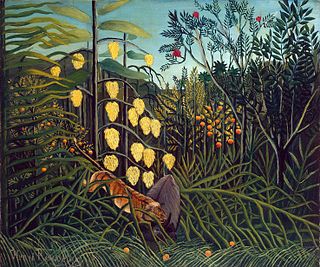
Primitivism is a mode of aesthetic idealization that either emulates or aspires to recreate "primitive" experience. It is also defined as a philosophical doctrine that considers "primitive" peoples as more noble than civilized peoples and was an offshoot of a nostalgia for a lost Eden or Golden Age.
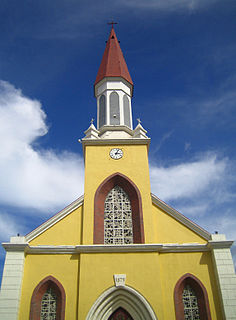
Notre Dame Cathedral is a late 19th-century church that serves as the cathedral of the Roman Catholic Archdiocese of Papeete. It is located close to the waterfront esplanade of the capital city on the rue du Général de Gaulle.

The Paul Gauguin Museum is a Japanese-styled art museum dedicated to the life and works of Paul Gauguin in Tahiti, French Polynesia. The Museum is closed for renovations - but the sister museum in Hiva Oa is open.

MS Paul Gauguin is a cruise ship that was completed in 1997. It primarily operates in the South Pacific. Paul Gauguin Cruises is headquartered in Bellevue, Washington.

Oviri is an 1894 ceramic sculpture by the French artist Paul Gauguin. In Tahitian mythology, Oviri was the goddess of mourning and is shown with long pale hair and wild eyes, smothering a wolf with her feet while clutching a cub in her arms. Art historians have presented multiple interpretations—usually that Gauguin intended it as an epithet to reinforce his self-image as a "civilised savage". Tahitian goddesses of her era had passed from folk memory by 1894, yet Gauguin romanticises the island's past as he reaches towards more ancient sources, including an Assyrian relief of a "master of animals" type, and Majapahit mummies. Other possible influences include preserved skulls from the Marquesas Islands, figures found at Borobudur, and a 9th-century Mahayana Buddhist temple in central Java.
Papeari is a village on the south coast of Tahiti. It is located in Tahiti-nui district, around 32 miles from Papeete.
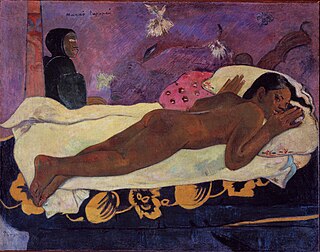
Spirit of the Dead Watching is an 1892 oil on burlap canvas painting by Paul Gauguin, depicting a nude Tahitian girl lying on her stomach. An old woman is seated behind her. Gauguin said the title may refer to either the girl imagining the ghost, or the ghost imagining her.
Paul Gauguin Cruises is a cruise line that was owned by Beachcomber Croisieres Limited until 2019, when it was purchased by French company Compagnie du Ponant. Paul Gauguin Cruises operates cruises with one luxury ship, the Paul Gauguin, to Tahiti, French Polynesia and the South Pacific.
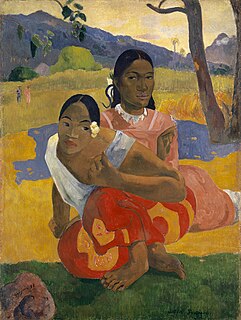
When Will You Marry? is an oil painting from 1892 by the French Post-Impressionist artist Paul Gauguin. On loan to the Kunstmuseum in Basel, Switzerland for nearly a half-century, it was sold privately by the family of Rudolf Staechelin to Sheikha Al-Mayassa bint Hamad Al-Thani, in February 2015 for close to US$210 million, one of the highest prices ever paid for a work of art. The painting was on exhibition at the Fondation Beyeler, Riehen, until 28 June 2015.

Nave Nave Mahana was made in 1896 by Paul Gauguin in Tahiti. It is kept in the Museum of Fine Arts of Lyon. The painting became part of the collections of the Lyon Museum in 1913.

Fatata te Miti is an 1892 oil painting by French artist Paul Gauguin, located in the National Gallery of Art, in Washington, DC.
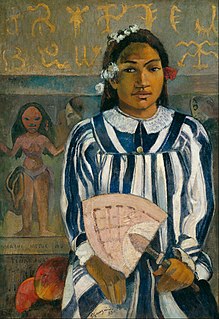
Merahi metua no Tehamana is an 1893 painting by the French artist Paul Gauguin, currently in the collection of the Art Institute of Chicago. The painting is a portrait of Paul Gauguin's wife Teha'amana during his first visit to Tahiti in 1891–1893. This marriage has always provoked controversy because it was arranged and completed in the course of a single afternoon and Gauguin claimed Teha'amana was just thirteen years old at the time.
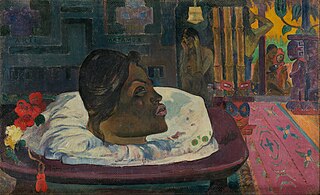
Arii Matamoe or The Royal End is a painting on coarse cloth by the French artist Paul Gauguin, created in 1892 during the painter's first visit to Tahiti. It depicts a man's severed head on a pillow, displayed before mourners, and although it did not depict a common or contemporary Tahitian mourning ritual, may have been inspired by the death of Pōmare V in 1891 shortly after Gauguin's arrival. A curator for the J. Paul Getty Museum suggested Gauguin likely painted the canvas "to shock Parisians" upon his expected return to the city.
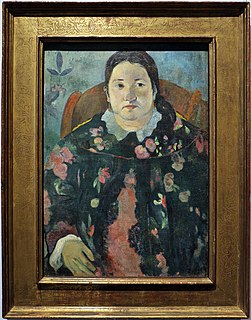
Suzanne Teriimarama Bambridge (1844–1911) was a leading social figure in Tahiti in the late nineteenth century.

Nevermore is an 1897 oil on canvas painting by the French Post-Impressionist artist Paul Gauguin. Since 1932 it has been in the collection of the Courtauld Institute of Art and on display in the Gallery. It was executed during the artist's second stay on the island of Tahiti in the South Pacific.


















